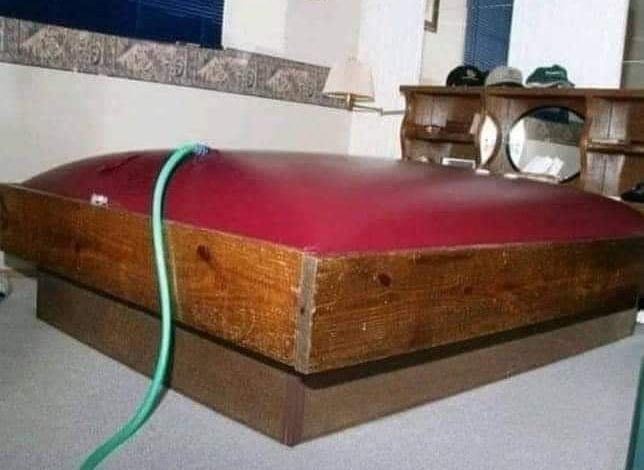
ADVERTISEMENT
The Waterbed Revolution: A Retro Icon of Comfort and Style
Introduction
The 1970s and 1980s brought a wave of innovation, creativity, and bold choices in lifestyle and home design. Among these trends, the waterbed emerged as a symbol of luxury and modern living. Sleek, unique, and undeniably attention-grabbing, waterbeds became a fixture in countless bedrooms, offering a blend of comfort and a touch of the futuristic. The image of a partially filled waterbed, framed by its sturdy wooden base, captures the essence of this cultural phenomenon. But beyond its novelty, the waterbed was a testament to an era’s adventurous spirit and evolving ideas about comfort and personal style.
Body
The waterbed, patented in 1971 by Charles Hall, was initially introduced as an innovative way to enhance sleep quality. Unlike traditional mattresses, the waterbed’s design promised unparalleled comfort by conforming perfectly to the body’s shape, reducing pressure points, and promoting better circulation. This made it particularly appealing to those seeking relief from back pain and other physical discomforts. Filled with water via a simple hose, the mattress was a feat of engineering, blending functionality with a unique sensory experience.
For many, owning a waterbed was about more than just sleep—it was a statement. The wooden frames that often accompanied these beds added a rustic charm, while the fluid motion of the mattress offered a futuristic, almost magical appeal. Waterbeds became synonymous with modern luxury, frequently appearing in advertisements as the ultimate way to relax and unwind. They were also a symbol of individuality, embraced by those who wanted something different from the standard box spring and mattress.
However, the waterbed’s popularity wasn’t just about aesthetics or comfort. It also became a cultural icon. From its appearances in movies and TV shows to its association with the free-spirited attitudes of the 1970s, the waterbed embodied a carefree, experimental lifestyle. Couples often appreciated its novelty, and it wasn’t uncommon to find these beds in homes that embraced other unconventional trends, like shag carpeting and lava lamps.
ADVERTISEMENT
Despite its initial success, the waterbed’s popularity began to wane in the 1990s. Practical concerns, such as the difficulty of moving the heavy, water-filled mattress, the risk of leaks, and the challenge of maintaining the right temperature, led many to opt for more traditional bedding. However, for those who owned a waterbed, these drawbacks were minor compared to the comfort and style it provided.
Today, the waterbed is a nostalgic relic of a time when bold design choices and experimental living were at the forefront of culture. Enthusiasts and collectors still celebrate its uniqueness, and for some, the waterbed remains a cherished part of their bedroom setup, reminding them of an era when innovation and fun were key components of everyday life.
Conclusion
The waterbed was more than just a mattress—it was a cultural statement that captured the imagination of a generation. Its blend of comfort, novelty, and style made it a must-have item in the 1970s and 1980s, symbolizing a spirit of individuality and adventure. While its popularity has diminished over the years, the waterbed continues to hold a special place in the hearts of those who experienced its unique appeal.
Whether remembered for its practicality, its quirks, or the sheer joy of floating on a mattress filled with water, the waterbed remains an icon of a bygone era. It reminds us that sometimes, the most memorable innovations are the ones that dare to be different, blending comfort with creativity in ways that leave a lasting impression.
ADVERTISEMENT




